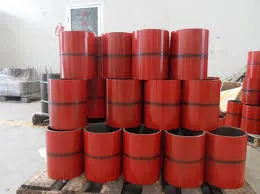2 月 . 15, 2025 18:42
Back to list
what is a pup joint
Understanding Pup Joints An Expert Insight into Their Utility and Application
Furthermore, in production scenarios, pup joints play a significant role in maintaining wellbore stability. They are often used to adjust the height of the tubing in a well, which is crucial in managing the pressure and flow rate of the extracted resources. By fine-tuning the production string, pup joints can help in optimizing oil and gas recovery, thereby significantly impacting the profitability and efficiency of a production operation. Pup joints are also essential in coiled tubing operations. These operations require a high degree of flexibility and precision, and the adaptability of pup joints makes them an ideal fit. During interventions or workovers, they enable operators to extend or shorten the length of coiled tubing to adjust to new wellbore conditions and intervention techniques, ensuring continued productivity without the need for significant down-time. From a quality assurance perspective, the manufacture of pup joints adheres to rigorous industry standards such as API (American Petroleum Institute) or ISO specifications. These benchmarks ensure that each product leaving a facility meets the necessary criteria for safe and effective use. A reputable supplier will provide a traceable line of documentation to back up product specifications, essentially guaranteeing that operators receive only the best components for high-stakes applications. In summary, pup joints are, despite their size, monumental in scope and function across various stages of oil and gas operations. Their design, material selection, functional versatility, and adherence to stringent industry standards equip them to handle the pressures and demands of high-stakes environments seamlessly. Thus, petroleum engineers and field operators alike view pup joints as an invaluable resource in their toolkit, ensuring both safety and efficiency in their operations. For those in the industry seeking to optimize their operations, understanding the applications and capabilities of pup joints is essential. Selecting the correct pup joint can significantly influence the productivity of a project and reduce the risk of costly interruptions. Companies and engineers must take into account the dynamics of their specific operations to incorporate pup joints appropriately, tapping into an indispensable resource that bridges the gap between ambition and achievement in oilfield operations.


Furthermore, in production scenarios, pup joints play a significant role in maintaining wellbore stability. They are often used to adjust the height of the tubing in a well, which is crucial in managing the pressure and flow rate of the extracted resources. By fine-tuning the production string, pup joints can help in optimizing oil and gas recovery, thereby significantly impacting the profitability and efficiency of a production operation. Pup joints are also essential in coiled tubing operations. These operations require a high degree of flexibility and precision, and the adaptability of pup joints makes them an ideal fit. During interventions or workovers, they enable operators to extend or shorten the length of coiled tubing to adjust to new wellbore conditions and intervention techniques, ensuring continued productivity without the need for significant down-time. From a quality assurance perspective, the manufacture of pup joints adheres to rigorous industry standards such as API (American Petroleum Institute) or ISO specifications. These benchmarks ensure that each product leaving a facility meets the necessary criteria for safe and effective use. A reputable supplier will provide a traceable line of documentation to back up product specifications, essentially guaranteeing that operators receive only the best components for high-stakes applications. In summary, pup joints are, despite their size, monumental in scope and function across various stages of oil and gas operations. Their design, material selection, functional versatility, and adherence to stringent industry standards equip them to handle the pressures and demands of high-stakes environments seamlessly. Thus, petroleum engineers and field operators alike view pup joints as an invaluable resource in their toolkit, ensuring both safety and efficiency in their operations. For those in the industry seeking to optimize their operations, understanding the applications and capabilities of pup joints is essential. Selecting the correct pup joint can significantly influence the productivity of a project and reduce the risk of costly interruptions. Companies and engineers must take into account the dynamics of their specific operations to incorporate pup joints appropriately, tapping into an indispensable resource that bridges the gap between ambition and achievement in oilfield operations.
Next:
Latest news
-
Unlock the Benefits of Pup Joints for Your OperationsNewsOct.31,2024
-
The Quality of Casing Couplings from ChinaNewsOct.31,2024
-
The Essential Role of Pup Joints in Drilling OperationsNewsOct.31,2024
-
The Benefits of Tubing Couplings for Your ProjectsNewsOct.31,2024
-
Enhance Your Drilling Operations with Tubing Pup JointsNewsOct.31,2024
-
Elevate Your Drilling Operations with Tubing CrossoversNewsOct.31,2024
Related Products







